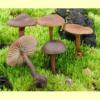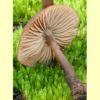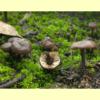
images/Lyophyllum_anthracophilum_group/Lyophyllum_KRT2981_Agaric_processed.jpg
Small to medium agaric, growing on the ground, with a white spore print. Pileus brown or grey, rarely black, not viscid. Lamellae adnate or subdecurrent. Stipe central. Partial veil remnants none. Spores hyaline, non-amyloid, smooth; germ pore absent. Cheilocystidia absent. Lamellar trama regular. Pileipellis a cutis. Clamp connections present.
The greyish fruit-bodies resemble some species of
Mycena, but that genus often has amyloid spores and nodulose pileipellis hyphae. Some
Gymnopus are similar in stature, but they rarely have a greyish pileus, often have a hairy stipe surface and do not occur on burnt ground. The pileus of members of the
Lyophyllum anthracophilum group can be smooth and waxy as is common in species of
Hygrocybe, but they are rarely grey or brown in colour and usually have much longer basidia. The
Lyophyllum tylicolor group differs in having ornamented spores.
Basidia of Lyophyllum are unusual in possessing siderophilus granulation when stained in a solution of iron and acetocarmine. Cleménçon (2004) and Largent et al. (1977) provided details of the specialised reagents required to detect this phenomenon.
Lyophyllum P.Karst.,
Acta Soc. Fauna Fl. Fenn. 2: 3, 29 (1881).
One or a few species, all occurring on burnt ground.
Lyophyllum anthracophilum (=
Tephrocybe,
T. carbonaria) has smooth, globose spores and
L. atratum (=
Tephrocybe) has smooth, ellipsoid spores. The correct name for Australian material is yet to be established.
Lyophyllum ambustum (= Tephrocybe), also a species of burnt ground, with rough spores, was reported from Victoria by Willis (1963). However, there is no voucher to confirm the identification.
This group is keyed out separately from other species of Lyophyllum because the rather non-descript greyish fruit-bodies do not grow in connate clusters.
Lyophyllum anthracophilum (Lasch) M.Lange & Sivertsen,
Bot. Tidsskr. 62: 205 (1966).
Vic. and Tas. (and probably also W.A., S.A. and N.S.W.).
In native forests and in gardens and pot plants. Common after fire.
On the ground.
Saprotrophic.
Breitenbach, J. & Kränzlin, F. (eds) (1991),
Fungi of Switzerland.
Volume 3. Boletes and Agarics 1st part. Edition Mykologia, Lucerne. [
Illustration,
Description and
Microcharacters of
L. anthracophilum]
Fuhrer, B. (2005), A Field Guide to Australian Fungi. Bloomings Books, Hawthorn. [The Description and Illustration of Tephrocybe aff. rancida seems to be closer to Lyophyllum anthracophilum, and the occurrence after fire also fits this species]




